 |
 |
Issue
No. 13 - February/March 2001
|
|
Welcome to the 13th edition of The
Teddington Cheese Wire. Now that we have fully recovered from the
hectic Christmas and New Year season, we would like to thank those
customers who placed their orders early. We are now preparing for
the busy Easter period, and we thought it an appropriate time to
produce our guide to catering for parties. There is also a chance
to win a prize with our crossword competition.
Obviously the recent
outbreak of foot and mouth disease has affected farming at all levels,
and our hearts go out to all of those stuck in the middle of it.
At the moment our suppliers are still releasing their cheese, although
all collections are now made at a distance from the farms with the
added precaution of disinfecting the vehicles. The outbreak has
meant however that we have had to suspend our worldwide delivery
service until further notice.
We were all saddened by the news
of the death of James Aldridge earlier this year. He was widely
regarded as one of the strongest influences in the resurgence of
'real' cheese over the last two decades. His presence in the specialist
cheese world will be greatly missed.
Did you see us on the television?
Some of the eagle-eyed amongst you may have noticed our brief appearance
on 'BBC Webwise', where our web site was featured as an example
of a thriving Internet business. Thank you to those who spotted
us and sent your kind comments.
|
|
|
This is a new feature of 'The Teddington Cheese
Wire'. We receive many e-mails from customers giving feedback
on the cheese. As well as finding out what our customers want,
we also discover new ideas and facts. In this edition, some
of the comments are published. If you have any ideas or feedback
on anything that may be covered by The Teddington Cheese Wire
please feel free to drop us an e-mail.
Comment
of the month
"You might be amused to know that with
all the strictures in the UK over what pregnant women should
eat, a move to France for the 9 months in question might make
life easier. We visited the Spa hotel at Evian, which has
100 years of treating people under its belt. There the nutritionist
I saw told me to increase my egg consumption by whisking an
egg into pasta sauces, and to increase my protein consumption
by eating some at each meal. The hotel had a magnificent cheeseboard
of many cheeses, and I enjoyed nearly all of them in the course
of a week. Many were undoubtedly unpasteurised. I read somewhere
that the only cases of listeria were from pasteurized cheeses.
Maybe one day the European Union will get its recommendations
for pregnant women sorted out (they thought even gentle tennis
was a bad idea while I was being encouraged to be as active
as possible at home), but I suppose until then, good sense
will have to prevail."
....... J.M. via e-mail
|
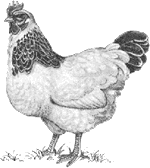
|
|
-
Cheese Tips -
Reusing your
mail-order cheese packaging
As
regular customers know, we send all of our deliveries out
in polystyrene boxes. With recycling in mind, most
people are reluctant to throw them away, and over the years
we have received a few suggestions on what to do with them.
1. If
you have a greenhouse, why not make a few holes in the bottom
of the polystyrene box, fill it with compost and use it for
growing seedlings.
2. Place
the boxes in the boot of your car, and you have a ready made
coolbox for your shopping.
|
|
DID YOU KNOW?
'Chalk & cheese'
This curious phrase actually
derives from farming practices in Wiltshire. The chalk grasslands
in and around Salisbury plain were farmed for mutton and wool,
whereas dairy farmers who produced local cheeses used the
lush green pastures of the North West. At Salisbury market,
the two groups would meet, but the quiet plains farmers never
mixed with the lively outgoing cow farmers. They were like
chalk and cheese!
|
Back to top |
|
-
Recipe -
TARTIFLETTE
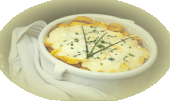
This recipe was only recently introduced
by the makers of Reblochon who needed to boost sales in the winter
months. Although its origins were not exactly traditional, the result
is fabulous, and has proven an instant hit in the Alps.
Ingredients
- 1 kg cooking potatoes, sliced
into thin pieces.
-
1 Reblochon (about 550g), with rind removed.
- Salt
and pepper to taste.
- Garlic and chives
- 200 ml Crème fraîche
Method
1.
Alternately layer potatoes and cheese together with the herbs and
spices.
2. Cook in the oven for
20 minutes at gas mark 6 (200c)
3. Add crème fraîche.
4. Return to oven for a
further 10 minutes.
5. Serve hot, with cold meat accompaniments and crusty bread.
|
|
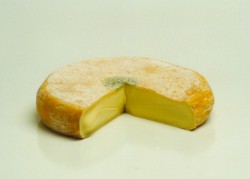
- Cheese focus -
Reblochon
Savoie, France
Reblochon derives from the word 'reblocher' which when literally
translated means 'to pinch a cow's udder again'. Although
graphic, this refers to the practice of holding back some
of the milk from the first milking. During the 14th century,
the landowners would tax the mountain farmers according to
the amount of milk their herds produced. The farmers would
therefore not fully milk the cows until after the landowner
had measured the yield. The milk that remains is much richer,
and was traditionally used by the dairymaids to make their
own cheese. The Chartreux monks would bless the houses of
the mountain peasants in return for these "cheeses of devotion".
Reblochon is traditionally made from the milk of three breeds
of cattle, the Abondance, Montbéliarde and the Tarine. It
was decreed as an A.O.C. cheese in 1958 and is therefore subject
to certain regulations to ensure the preservation of its name,
quality and status. This includes renneting within 24 hours
of the last milking and bringing the milk to the place of
production as soon as possible after milking.
The flavour of Reblochon is delicate and subtle. It is a
very fresh tasting cheese and the smell also reflects this.
The paste is smooth and ivory coloured, with a supple texture.
The natural rind varies from yellow to orange and usually
has a light covering of white mould.
Each cheese is 9-14 cm in diameter, 3-3.5 cm high, weighs
240 - 550g and has a fat content of 45%. Affinage (maturation)
takes only 2-4 weeks. Although it can be made on an industrial
scale as indicated by a red label, ours is a fermier cheese,
denoted by the green casein label on the rind. This means
that the whole production is carried out on one farm and milk
from neighbouring farms is not allowed. Each Reblochon comes
sandwiched between two wafer thin wooden discs.
Reblochon is excellent on the cheeseboard, perhaps with a
glass of Savoie wine, or can be enjoyed when melted on baked
potatoes. It was made famous by the recently invented Tartiflette
(see recipe).
|
|
|
- Cheese Tips
-
Catering for parties
When organizing an event such as a
cheese and wine evening or a dinner party, it is always difficult
to judge amounts as well as providing a balanced cheeseboard.
At The Teddington Cheese we have come up with a few simple
tips to help you choose the perfect selection for your event.
Amounts needed will obviously vary
depending on the event, but as a general rule of thumb we
suggest the following:
For events where cheese is the main
feature, such as a cheese and wine evening, we would recommend
4- 6oz or 100-150g per cheese eater. For events such as dinner
parties where cheese is one course of the meal, reduce the
quantities to 2-4oz or 50-100g.
Each piece of cheese should be large
enough to look the part on a cheeseboard. Avoid the temptation
to have lots of varieties of cheese. Smaller pieces can look
lost when presented on a cheeseboard. Through experience we
have found that the optimum number of cheeses is 5. Try to
adjust the amount per cheese rather than the number of cheeses,
and where possible aim for at least 200g per cheese. Of course
some individual cheeses are smaller than this, but make an
equally attractive addition to the selection.
When choosing the types of cheese,
try to aim for a balanced selection. Maybe choose variety
of colours e.g. blue veined and orange, and/or a variety of
milk types such as cow, goat and ewe. Remember to take into
account different people's needs, such as hard pasteurized
cheeses for those who are pregnant, or milder ones for children.
When presenting the cheese, remember
to allow a good couple of hours for it to reach room temperature,
and most of all, enjoy it!
|
|
|
Don't
forget Mother!
As an alternative to flowers or chocolates
for Mother's day, why not send her a carefully chosen
selection of cheese.
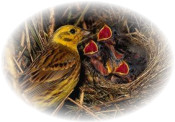 |
MOTHER'S
DAY:
1st
April 2001
|
Available
as part of the cheese
club
|
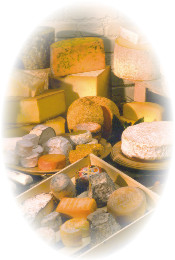 |
|
|
- Competition -
Cheese Crossword
Test your knowledge
of cheese with our crossword. Print out the crossword, answer the
clues and post it to: Crossword Competition, The Teddington Cheese,
42 Station Road, Teddington, Middlesex TW11 9AA. Alternatively,
you can e-mail your answers to dougandtony@teddingtoncheese.co.uk
. For security reasons, please do not use attachments.
A draw of the winning
entries will be made on St.George's Day, 23rd April. The winner
will receive a 19 across, a 21 across, 200g of 16 down, 200g of
8 down and 200g of 12 down. Prize includes delivery to UK addresses
only. (Entries will be accepted from all countries but, because
of the delivery restrictions, you will need to make a gift of the
prize to a friend or relative in the UK).
|
|
Across
2. Precise geographical origin of Brie (3,2,6)
6. See 27 across - extra matured (14)
9. British sheep's cheese - Grommit! (11)
14. Early Summer month (3)
15. Region of France famous for its washed-rind cheese (6)
17. ___ y Bont - sadly no longer made (3)
18. This plays a key role in the Emmental-making process
20. Camembert has a ___ content of 45% (3)
22. These coat the surface of Caboc (4)
24. _______ Cross. English goat's cheese (6)
27. Hard Swiss cheese (7)
29. What one might associate with Cotherstone (3)
30. A square camembert-like cheese from Normandy (4, 7)
|

|
|
Down:
1. A soft, creamy sheep's cheese (7)
3. Female sheep (3)
4. Italian word meaning strong (5)
5. The initials of the maker of Lancashire (2)
7. Unusual Welsh cheddar with mustard seeds (6)
8. Put his name to Yarg (4)
10. A preservative, now used to alter the flavour
of cheese (5)
|
11. An example of these is annato (4)
12. A cheese with walnut-sized holes (8)
13. What one may intend to do with cheese (3)
16. French term meaning 'refine the taste'
- maturation (8)
17. Cheese named after mountain range in Northern Spain (5,4)
19. Napoleon tasted this cheese and approved
(9)
|
21. ___ Amsterdam, a Gouda (3)
23. _____ de Moine. Used on a Girolle machine.
25. The form many cheeses take, especially goat's such as St. Maure
(3)
26. Not Mr. Winton! Where livestock often graze (4)
28. ___ De Cave. An ingeniously designed candle for the cheese and
wine cellar. (3)
|
Back
to top
|
|
-
Tools of the Trade -
THE CHEESE VAT
The vat is possibly the most important and expensive piece of equipment
for the small-scale cheese maker. This is where the rennet and starter
are added to the milk to initiate coagulation of the curds. The
vat is also where the curds are cut and the whey is drained off.
For cheddar-type cheeses the vat is used for the process known as
'cheddaring'.
Vats today are generally made from stainless steel and have a 'jacket'
or hollow outer skin. Steam passes through the jacket to uniformly
heat the vat. This enables the cheese-maker to closely control the
temperature for the milk, which is essential to ensure consistent
quality of the cheese. For some cheeses (such as Emmental and Gruyere),
the vat is used to heat the curds while in the whey. This 'cooking'
gives this type of cheese its unique character.
All vats have a tap at the base. This allows the whey to drain
off, leaving the curds. The cheese maker will usually push the curds
to the side of the vat to allow the whey to escape through a hole
in the middle. The hole usually has a filter to keep the curds in
the vat.
|
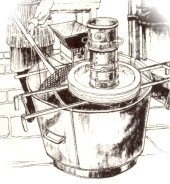
|
| Above:
Old fashioned vats were simply 'tubs' |
|

Above:
lifting the cut curds out of the vat
|
|
| Back
to top |
|
| All
articles © www.teddingtoncheese.co.uk |
|
|









